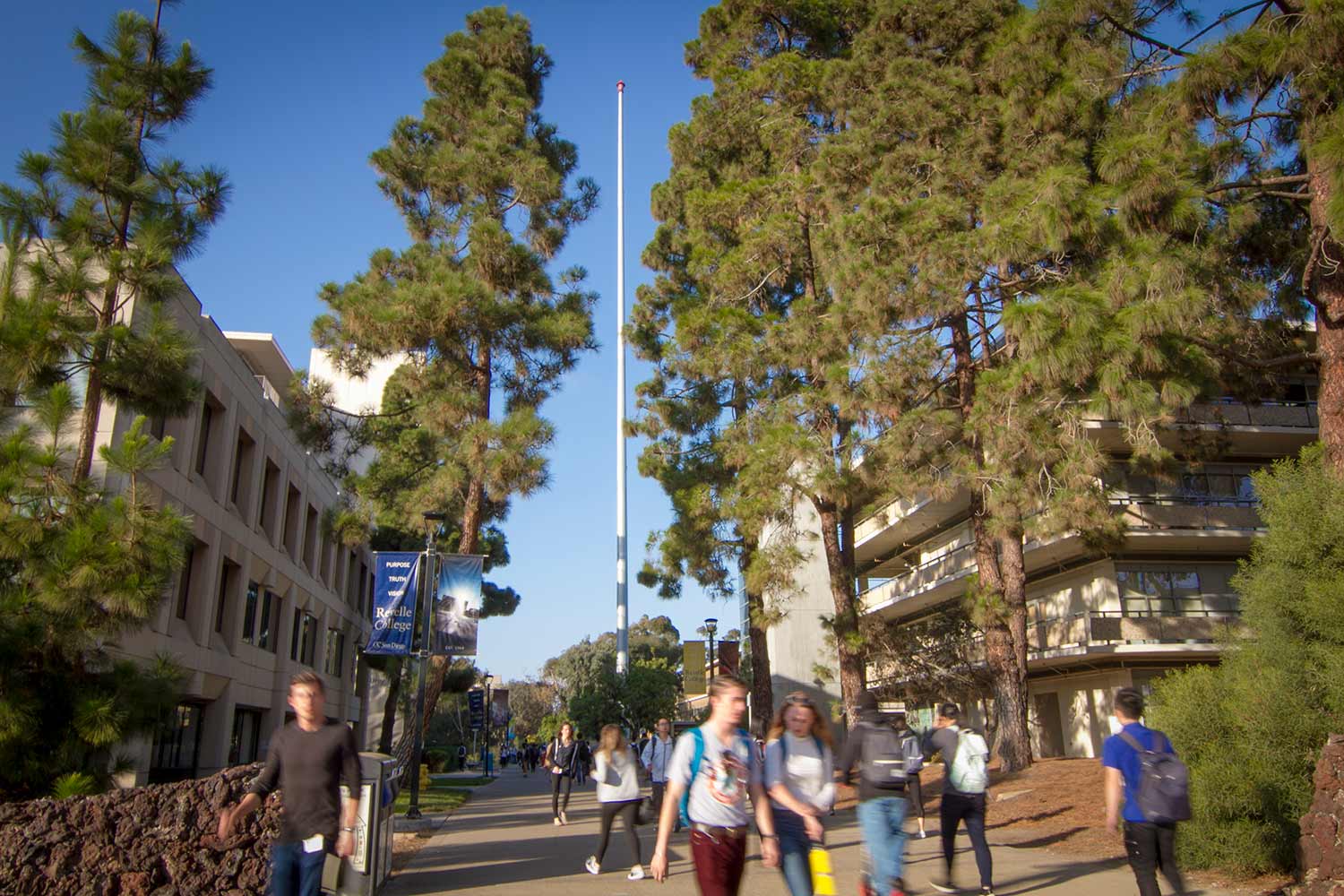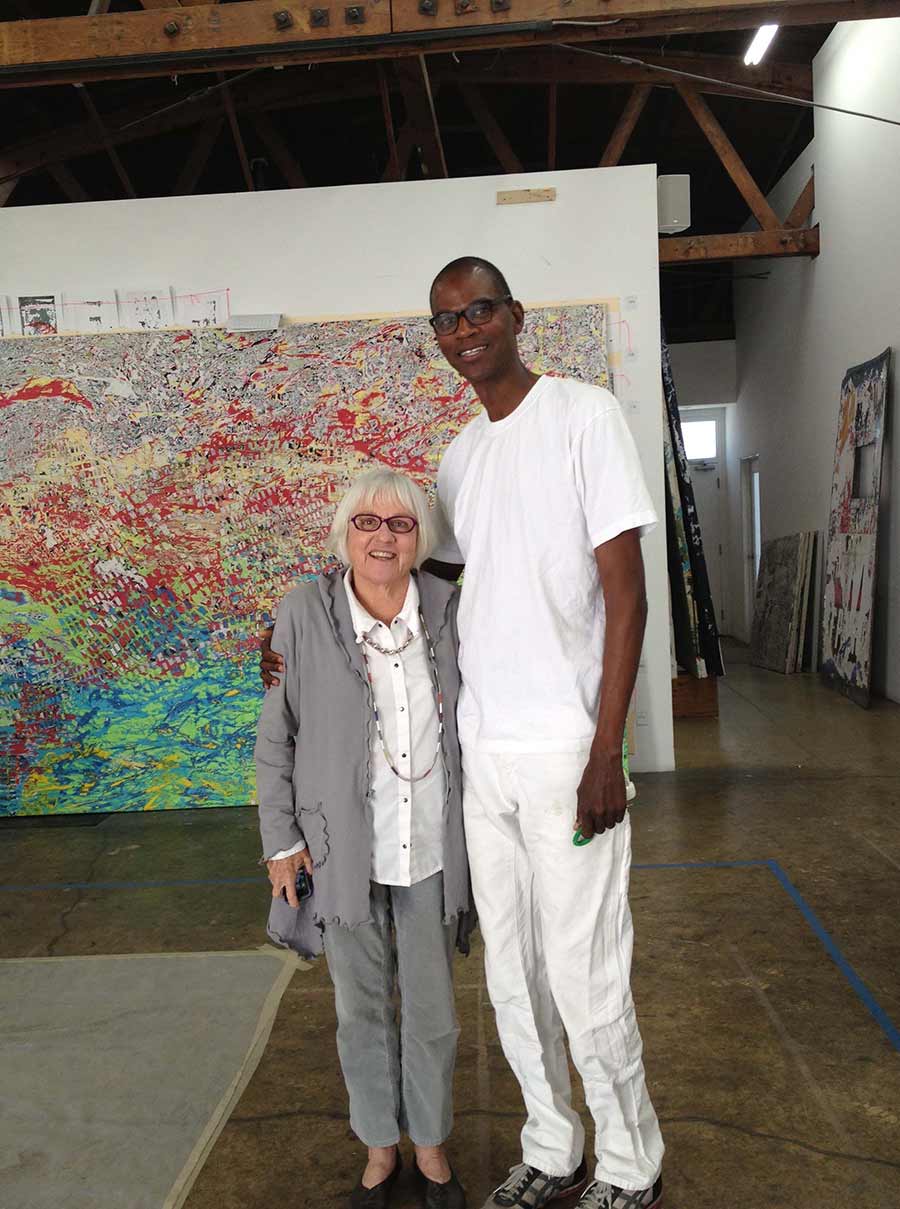By:
- Erika Johnson
Published Date
By:
- Erika Johnson
Share This:

Contemporary artist Mark Bradford’s new sculpture—the 20th addition to UC San Diego’s Stuart Collection— is a monumental ode to the origins of today’s lightning-speed communications. Photo by Erika Johnson/UC San Diego Communications.
Monumental Sculpture Pays Homage to the First Instant Message
Artwork by Mark Bradford one of three new additions to UC San Diego’s Stuart Collection
At 195-feet-tall, it is the tallest structure on campus. Contemporary artist Mark Bradford’s new sculpture is a monumental ode to the origins of today’s lightning-speed communications. It is the 20th addition to UC San Diego’s renowned Stuart Collection, a unique collection of site-specific works by leading artists of our time. His work is soon to be followed by two more pieces, including a mural by Alexis Smith and a sensory environment by Ann Hamilton.
Bradford’s conspicuous work stands prominently in Urey Plaza in Revelle College. Perched high atop an industrial pole, a lamp blinks silently, fast and slow. The sculpture continuously signals in Morse code, transmitting the first message ever sent by electric telegraph: “WHAT HATH GOD WROUGHT.” The experiment was led by Samuel Morse and his partner Alfred Vail in 1844 and marked an important step in launching our nation’s communication network.
The sculpture, titled WHAT HATH GOD WROUGHT, is intended to reflect on the powerful influence of technology while silently referencing impending change. The campus and local community are invited to learn more about the piece from Bradford, who will speak at 6 p.m. on Dec. 1 in Galbraith Hall.

Stuart Collection Director Mary Beebe with artist Mark Bradford.
“Mark is a crusader for social change while at the same time being one of the most successful painters of his generation,” said Director of the Stuart Collection Mary Beebe, who first invited Bradford to consider creating a work for the campus in 1995. “At first he wasn’t interested in doing a permanent work. I’d call him every few years, and finally he said, ‘I like your persistence and I like what you’ve been doing.’”
Bradford visited UC San Diego in May 2013 to discuss possibilities. Meandering the campus with Stuart Collection Project Director Mathieu Gregoire and Revelle College Provost Paul Yu, they made an exciting discovery. In the plaza adjacent to Urey Hall, they uncovered a forgotten plaque. It marked the spot where, in 1961, leaders of the newly founded university dedicated the site where construction broke ground. It was a fortuitous sign that Bradford’s retrospective work should reside where UC San Diego’s story began.
The luminaire that crowns the work harkens to a time long past, but one that is inextricably tied to the instant messages that pervade our lives today. Fabricated by the Marine Sciences Development Center at Scripps Institution of Oceanography, the lamp’s 300 LEDs can be adjusted for intensity and color, shining brighter on sunny days and dimmer at night.
Bradford was born in Los Angeles and is known for producing large-scale, abstract paintings and collages made from leftover artifacts from city spaces. He builds up layers of found materials, then cuts away at them, revealing a kind of map of urban life, networks and relationships. In 2009, he was awarded a MacArthur Fellowship, followed by a National Medal of Arts in 2015. Two years later, Bradford was selected to represent the United States at the Venice Biennale, a prestigious international art exhibition.
Bradford’s sculpture is one of three new pieces planned for the ever-expanding Stuart Collection. A 20 by 60-foot mural by artist Alexis Smith will be displayed in the North Torrey Pines Living and Learning Neighborhood when it is completed in 2020. The painting, titled “Same Old Paradise,” served as the inspiration for Smith’s “Snake Path,” the sinuous trail that connects Warren Mall to Geisel Library.

“Same Old Paradise,” Alexis Smith, 1987. Stuart Collection, UC San Diego. Photo by Philipp Scholz Rittermann.
The idea for the mural came to Smith in a dream she had while visiting San Diego over three decades ago. She describes the work as a “distilled vision of the promise of the open road and a fruitful land most commonly referred to as the American dream.” Below the metamorphosing snake, eight panels feature souvenirs representing an American road trip, along with an eight-sentence recap of Jack Kerouac’s novel “On the Road,” which served as inspiration for the painting.
On the east side of campus, another work is distilling. Massive trackways are taking shape on the periphery of campus in preparation for the trolley arrival. The movement of people and the opportunity to create an immersive sensory space piqued the interest of artist Ann Hamilton.
She visited the campus in 2013 to talk about a proposal that involves a series of swings that will hang from the Pepper Canyon transit station trestle as well as a 400-foot embossed pathway that leads into the heart of the university. The passageway is envisioned as a concordance featuring hundreds of quotations from faculty members and other notable figures connected to the campus such as Thurgood Marshall and Eleanor Roosevelt. Running down the middle are intersections that the passages share. The work, still in development, will be the collection’s 22nd installation.
All pieces in the Stuart Collection are site-specific, permanently built into the university’s landscape and architecture. Each sculpture is funded by private donations and must be approved by an advisory board—comprised of museum directors, artists, educators and community members—as well as the Chancellor’s Office. The process can take years, but the product is often notoriously bold.
Share This:
Stay in the Know
Keep up with all the latest from UC San Diego. Subscribe to the newsletter today.



